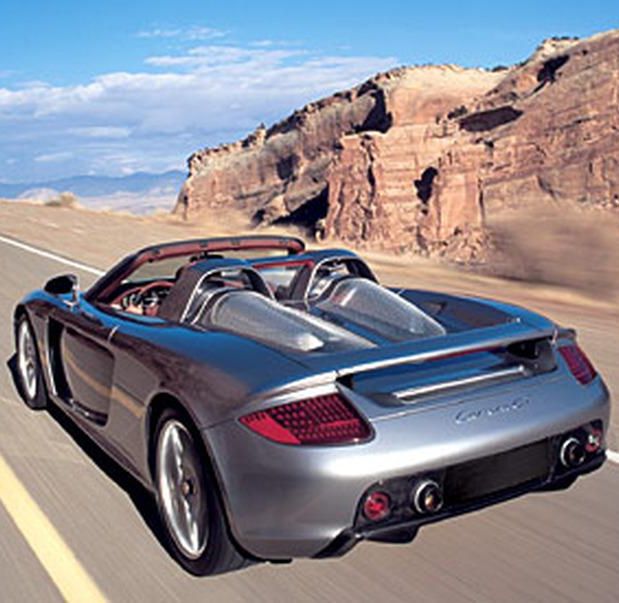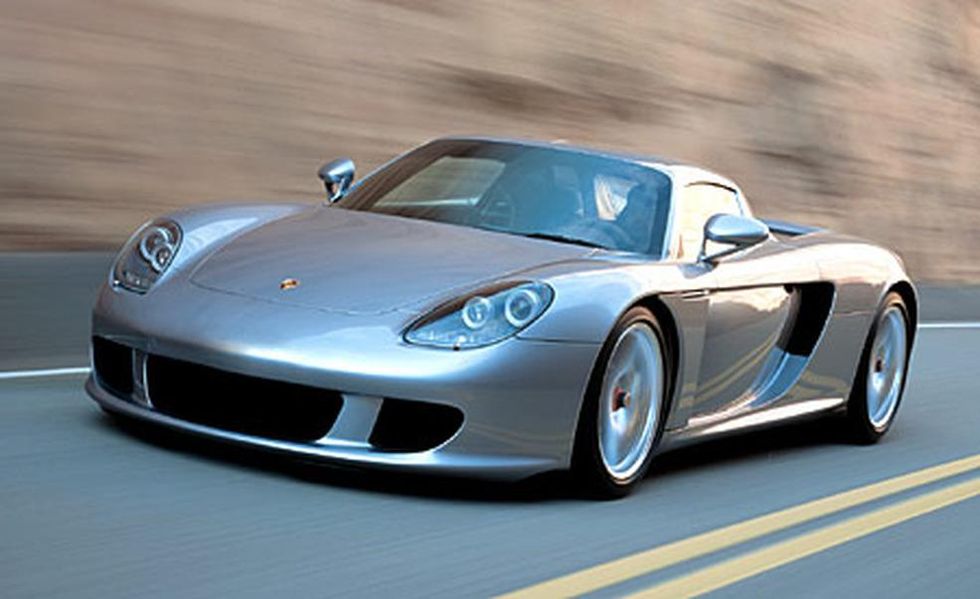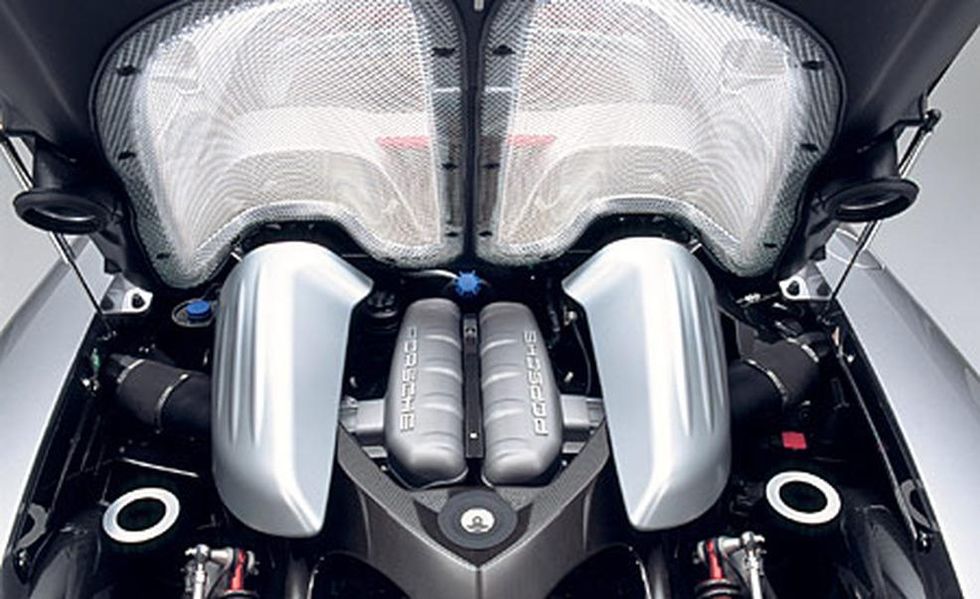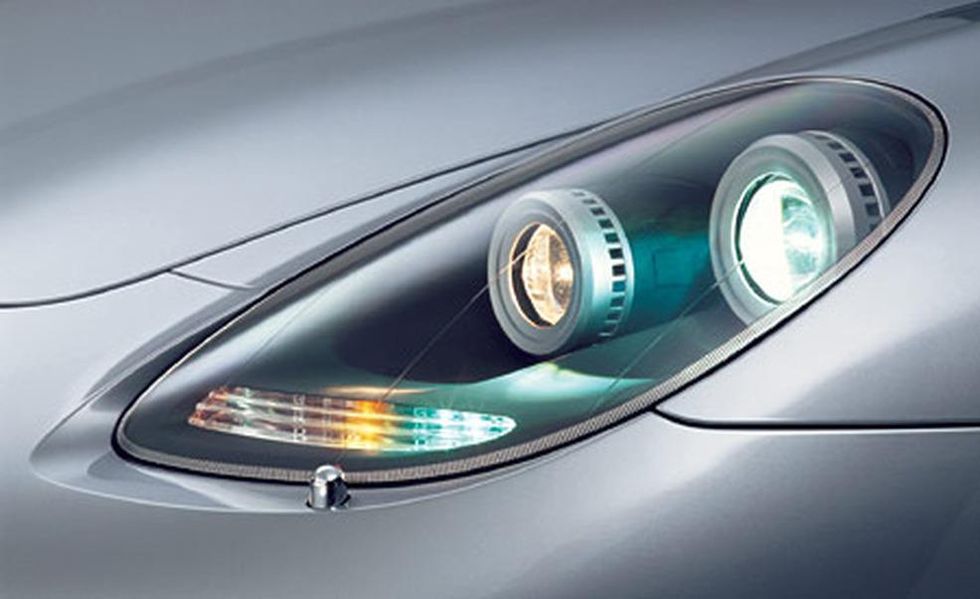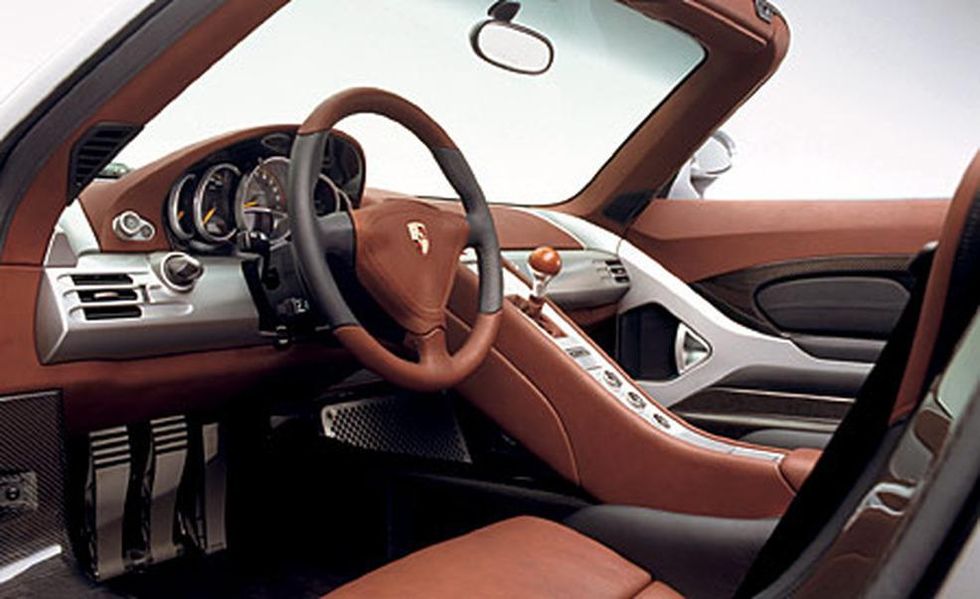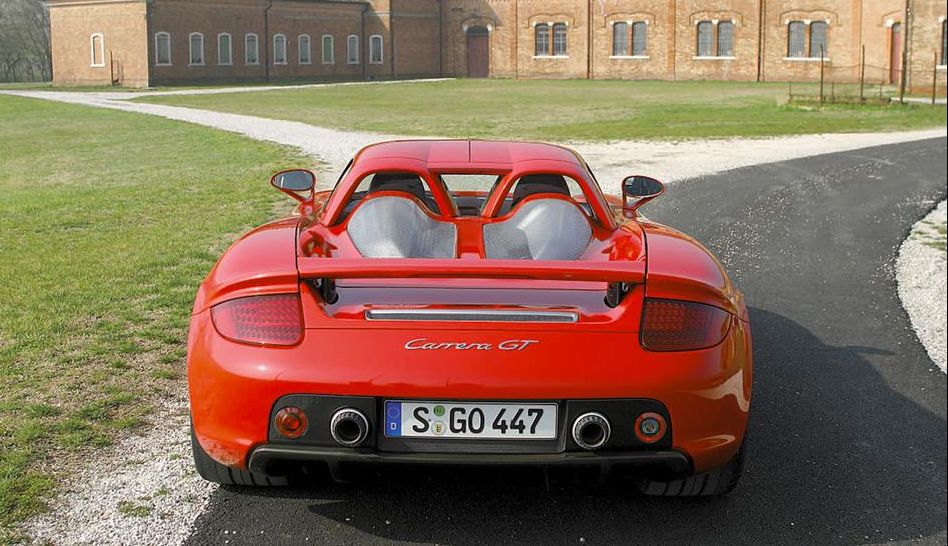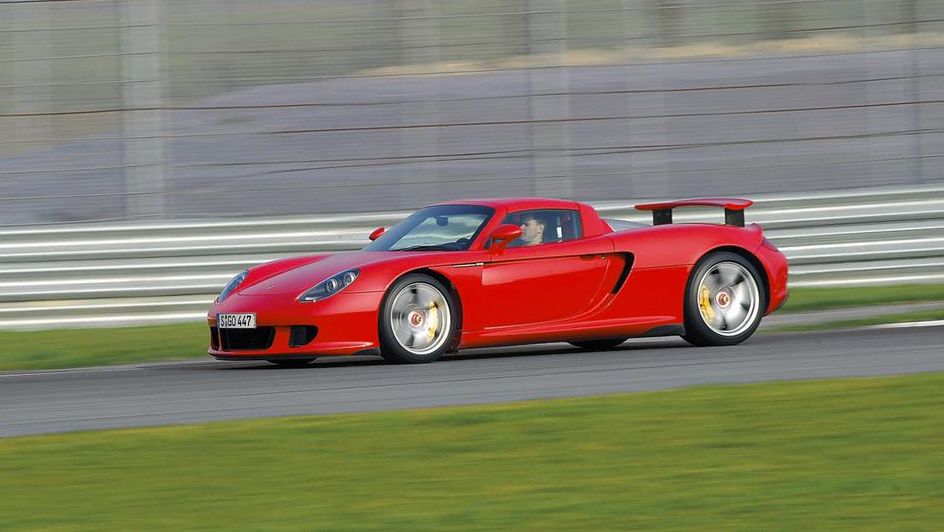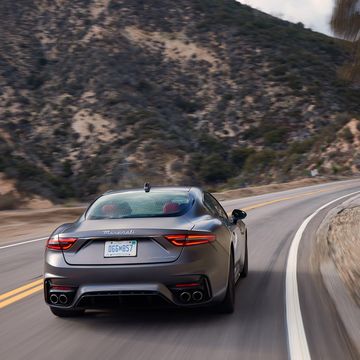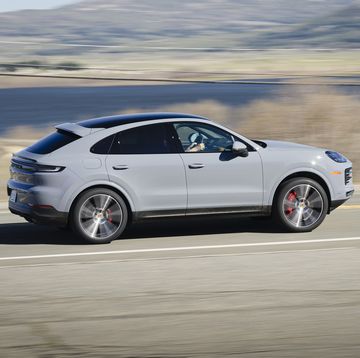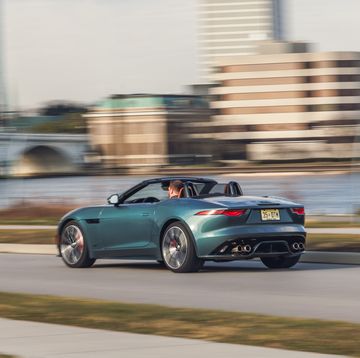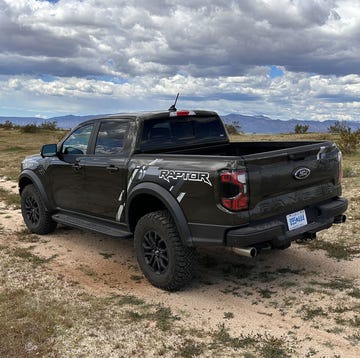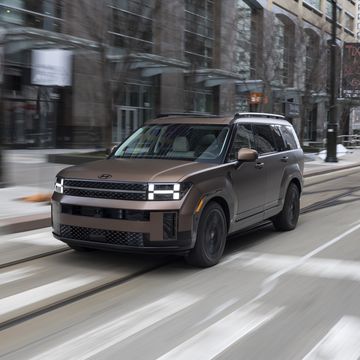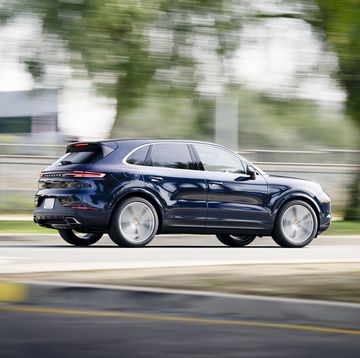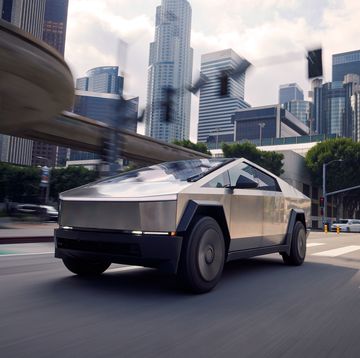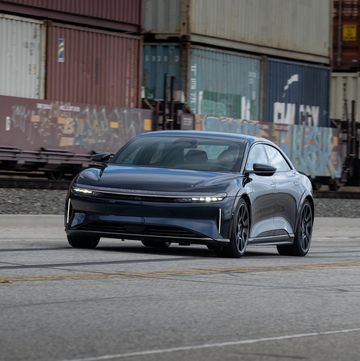From the June 2004 issue of Car and Driver.
Ferdinand Porsche would be proud of the Carrera GT. The company he founded in 1948 has produced an amazing string of sports cars that was only recently interrupted by—of all things—a truck. If the introduction of that Cayenne sport-ute had you wondering if the folks from Zuffenhausen had gone soft, think again. The exotic $448,400, 605-hp Carrera GT revealed here is arguably the finest sports car the company has ever produced.
It is an incredible car, with a plethora of juicy technical details and glorious thrust from a mid-mounted aluminum V-10 engine. We learned about both during a day of testing and driving at Italy's Adria International Raceway.
Remember the Acura NSX, the car that brought family-sedan drivability to the supercar ranks? Porsche has done much the same thing here, but with the performance bar raised to a dizzying height. Let's check the numbers.
The 60-mph run isn't a sprint; it's simply a first stride in this car. It's gone in 3.5 seconds. A scant 3.3 seconds later, 100 mph arrives. By the time your brain has caught up with the ever-increasing velocity, the GT has passed 130 mph—in 10.8 seconds, and hey, was that the quarter-mile marker at 11.2 seconds and 132 mph? The comparison with the $659,430, 650-hp Ferrari Enzo is inevitable, so here goes: The Enzo gets to 60 in 3.3 seconds, 100 in 6.6, and the quarter in 11.2 seconds at 136 mph.
So the Enzo is a few ticks quicker, but consider this: Unlike the Enzo, which has an automated manual transmission that automatically operates the clutch and shifter, the Carrera GT has a good ol' six-speed manual and a traditional clutch. Although we tried our best, the Carrera is extremely hard to get off the line cleanly. The 5.7-liter V-10 engine has about zero inertia. Breathing on the gas pedal sends the revs soaring. Likewise, if you lift off, they plummet. And the engine is all too willing to overpower the rear tires.
The clutch operates like an on/off switch and is tough to engage smoothly. Unlike a regular clutch that has only one friction disc, the GT has four and is about two-thirds the diameter (6.7 inches) of a standard Porsche 911 clutch.
It and the dry-sump oil system allowed engineers to mount the engine lower (the crankshaft is only 3.9 inches off the carbon-fiber underbody tray) and reap the handling benefits of a lower center of gravity.
The clutch engages in maybe the last inch of the floor-mounted pedal's travel. The best way we found to get the car rolling was by slowly releasing the pedal without giving it any gas. Every time we added some throttle, the car stalled or we smoked the tires. Pulling into dense traffic produces sweaty palms. The Carrera GT is, however, terrifically durable. We saw one car endure about 40 drop-clutch launches with no ill effect on its performance.
The rest of the car is a pure joy. Flat steel rods join the high-mounted shifter to the transmission and provide a satisfying mechanical feel that makes you glad you have to shift the old-fashioned way.
That free-revving engine is unlike anything else we've ever sampled. It's loud, blowing 93 decibels on our sound meter during a full-throttle blast, but the shriek is the kind that prickles your body hair. The power peak is high (605 horsepower at 8000 rpm), as is the torque (435 lb-ft at 5750 rpm), but the engine is quite flexible.
The GT needed only 3.7 seconds to accelerate from 5 to 60 mph. And even in sixth gear with the engine burbling at 1200 rpm, it pulled from 30 to 50 in 4.3 seconds and from 50 to 70 in 4.8 seconds. (We didn't perform those tests on the Enzo, but a $283,600 Lamborghini Murciélago took 6.1 and 5.8 seconds, respectively, and a Corvette Z06 needed 9.5 and 9.4 seconds.)
The engine, the gearbox, and the differential reside in a lightweight carbon-fiber subframe that bolts to a bulkhead behind the two seats. Since the subframe carries the structural load, Porsche used three flexible engine mounts—one in front and two at the rear—to isolate the chassis from engine vibrations.
There's carbon fiber throughout the car. The carbon-fiber chassis is made by ATR, the same company that produces the Enzo's chassis. It's formed by placing about 1000 pieces of carbon-fiber cloth on molds that are first vacuum-bagged to prevent air bubbles and then cured under high temperature and pressure in an autoclave.
The idea, of course, is to save weight. And Porsche engineers are fanatical pound pinchers. Even the seats, like the body, are carbon fiber and weigh about 23 pounds, half as much as each 911 perch. The wheels are forged magnesium and weigh about a third less than conventional aluminum rims. Aluminum was used in place of steel for the upper control arms and front crush structure. The engine designers helped the weight shaving with titanium connecting rods and cast the engine oil tank into the transmission housing. The oil passages that run to and from the engine are internal, so there are no external lines.
"Then why," we asked this car's project manager, Michael Hölscher, "does the 3146-pound GT weigh almost the same as a 3181-pound Corvette Z06?"
There are many reasons, but a major one is the removable roof section. Achieving the desired bedrock chassis stiffness Porsche wanted in an open-top car required adding extra material to the chassis. Hölscher wouldn't quote any numbers but said it's probably the stiffest car on the road today. After our brief drive, we think he might be right. He also pointed to the bank of three large radiators that fill the nose of the car. "It will never overheat," he pledged. Add in about 40 pounds of filler to give the carbon-fiber body a durable shiny finish, air conditioning, and the general beefing up of components to deal with the forces of 605 horsepower, and suddenly you're at standard road-car weight.
At least the company didn't skimp in the passenger compartment. There was legroom and headroom to spare for this six-foot-one test driver. The view out is fantastic, with a drop-away hood that seemingly lets you see a dime a foot in front of the car's nose. The shifter is mounted high but not uncomfortably out of reach. And despite the absence of a backrest adjustment, the deeply sculpted, thinly padded seats felt perfect. Makes you wonder why everyone doesn't ditch heavily padded seats for these well-designed shells. The crowning touches are the subtle elbow pads on the center console and door.
The cockpit is the perfect place to experience the Carrera GT's handling precision. There are a few concessions to comfort, including vibration-absorbing engine mounts and the addition of air conditioning, but the suspension is all business. For example, the control arms are mounted to the chassis by spherical bearings instead of the usual rubber mounts that filter road noise but allow small deflections to minutely change the positioning of the wheels.
The carbon-fiber chassis provides some inherent sound dampening, but you can still feel and hear even small road cracks. Large frost heaves send an alarming crack through the chassis, but over moderate bumps, the ride is firm and surprisingly resilient.
Thoughts of ride quality quickly faded as we barreled into a tight hairpin at 135 mph. Here's where we'd like to brag about our abilities to keep this flailing beast on the track. But we can't—the GT's excellent manners and tremendous grip make difficult maneuvers seem easy.
We didn't record any notes on the steering feel. We didn't forget to—it's just that it felt quite natural. There's power assist, but it doesn't vary with vehicle speed. Yet the effort builds with cornering speeds, and you always get a sense of how close the tires are to their cornering limits.
Those limits are fantastically high. Although there wasn't a skidpad at the track, our Racelogic VBOX GPS data logger recorded 1.10 g in slow corners and 1.19 g in faster corners, where the car's aerodynamics (the spoilers and the underbody diffusers) likely added enough downforce to enhance grip. Since some of the corners appeared to have subtle banking, we'll have to wait until we get the GT on a skidpad to compare it with other cars.
The brakes, too, are wonderful. Stopping from 70 mph takes only 145 feet—six fewer than the Enzo. The pedal is firm, and you can use the anti-lock system to cut down the majority of straight-line speed and then effortlessly ease off to trail-brake into the corners.
It wasn't the outright speed that floored us. We expected that. It was the easy controllability. Those rigid suspension mounts may be a bit annoying on the road, but on the track they provide a stream of tiny signals that impart confidence. We tried, but we never found a way to upset the chassis. It's simply glued to the road.
The way we see it, a little bit of road noise and a grabby clutch are small prices to pay for a sports car that until now was simply a dreamy doodle in study hall. It's as fast as anything else on the road, but it offers an open roof and an immensely satisfying level of driver involvement.
There's also a curious link to the past. The GT is not the first mid-engined, V-10-powered Porsche. Just such a car was designed back in 1939 but never built. Dubbed the Type 114, its two-seat coupe body strongly resembled the VW Beetle. It was no people's car, however, with a water-cooled 1.5-liter aluminum V-10 that bolted to a rear-mounted five-speed manual transmission. The war effectively killed any production plans, and Ferdinand Porsche died in 1951. Yet clearly, his genius carries on.
Specifications
Specifications
Porsche Carrera GT
VEHICLE TYPE
mid-engine, rear-wheel-drive, 2-passenger, 2-door Targa
PRICE AS TESTED
$448,400 (base price: $448,400)
ENGINE TYPE
V-10, aluminum block and heads
Displacement
350 in3, 5733 cm3
Power
605 hp @ 8000 rpm
Torque
435 lb-ft @ 5750 rpm
TRANSMISSION
6-speed manual
DIMENSIONS
Wheelbase: 107.5 in
Length: 181.6 in
Width: 75.6 in
Height: 45.9 in
Curb weight: 3146 lb
C/D TEST RESULTS
60 mph: 3.5 sec
100 mph: 6.8 sec
120 mph: 9.4 sec
Rolling start, 5–60 mph: 3.7 sec
¼-mile: 11.2 sec @ 132 mph
Top speed (redline limited, mfr's est): 205 mph
Braking, 70–0 mph: 145 ft
EPA FUEL ECONOMY
City/highway: 10/16 mpg
